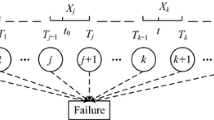Abstract
An improved prediction algorithm of the hidden semi-markov model (HSMM) is proposed to predict the remaining useful life (RUL) of aluminum reduction cells (ARC). First, the degradation process of the ARC is analyzed, and the parameters that could characterize its degradation process are determined. Second, to facilitate the prediction of HSMM, exponential distribution, in which form the dwell time in the traditional HSMM is distributed, is replaced with the Erlang distribution based on the queuing theory. Third, an improved forward recursion algorithm that introduced dwell time has not only simplified the calculation of useful life predictions but also further facilitated HSMM in the prediction of the RUL. Finally, verification is carried out using the actual data of an aluminum electrolytic industry, and the results showed that the improved HSMM performed better in the prediction and is more accurate than the existing prediction method.








Similar content being viewed by others
References
Y.X. Liu, Modern Aluminum Electrolysis (Metallurgical Industry Press, Beijing, 2008), pp231–254.
R. Pelletier, C. Allaire, and O.-J. Siljan, JOM 53(8), 18 (2001).
Y.W. Wang, J.P. Peng, and Y.Z. Din, JOM 70(9), 1877 (2018).
H.T. Chen, B. Jiang, S.X. Ding, and B. Huang, IEEE Trans. Intell. Transp. Syst. 23(3), 1700 (2020).
X. Yang, J.J. Gao, L.L. Li, H. Luo, S.X. Ding, and K.X. Peng, Automatica 122, 109246 (2020).
A. Gheribi, M. Fini, L. Rivoaland, D. Lombard, G. Soucy, and P. Chartrand, Metall. Mater. Trans. B. 51(1), 161 (2020).
S. Senanu, Z.H. Wang, and A.P. Ratvik, JOM 72(1), 21 (2020).
Z. Fang, K. Zhang, and X.J. Lu, Trans. Nonferrous Met. Soc. China 23(6), 1847 (2013).
W. Wang, and K. Sun, Russ. J. Nonferrous Met. 61(3), 241 (2020).
J.R. Cui, W.H. Li, C.G. Su, B. Cao, R.Y. Huang, X. Yang, and Q. Li, Light Met. 11, 30 (in Chinese) (2021).
X. Yang, Y. Zhang, Y. Shardt, X.L. Li, J.R. Cui, and C.N. Tong, IEEE Trans. Control Syst. Technol. 28(6), 2523 (2020).
R. Li, W. Verhagen, and R. Curran, Aerosp. Sci. Technol. 102, 105877 (2020).
N. Omri, Z. Al Masry, N. Mairot, S. Giampiccolo, and N. Zerhouni, Comput. Ind. 127, 103414 (2021).
Y.R. Yan, W.C. Lu, Z.W. Su, F.Q. Liu, L.M. Zhang, N.Y. Chen, J. Chin. Rare Earth Soc. 24(10), 218 (2006). (in Chinese)
W.C. Yi, The Service Life Prediction of 300KA Prebaked Anode Aluminum Reduction Cell. North China University of Technology, Beijing, 08 May 2017. (in Chinese)
D. Wang, X.D. Wang, and S.H. Lu, Symmetry 11(8), 1018 (2019).
D.Y. Han, J.S. Yu, and D.Y. Tang, Qual. Eng. 33(2), 208 (2021).
W.H. Yang, and L. Chen, Comput. Ind. Eng. 158, 107430 (2021).
B. Carey, M. Dan, and A. Tarik, Mech. Syst. Signal Process. 14(4), 597 (2000).
M. Dong, D. He, P. Banerjee, and J. Keller, Int. J. Adv. Manuf. Technol. 30(7/8), 738 (2006).
X. Li, M. Viliam, H.F. Zuo, and J. Cai, Comput. Ind. Eng. 119, 21 (2018).
T.J. Yang, Z.Y. Zheng, and L. Qi, Comput. Ind. 122, 103295 (2020).
Q.M. Liu, D.G. Li, W.Y. Liu, T.B. Xia, and J.X. Li, Energies 14(24), 8208 (2021).
The Nonferrous Metals Society of China, Code for Design of Aluminum Smelter Processes (China Jihua Press, Beijing, 2013), pp1–20. (in Chinese).
Y.H. Chen, C. Yi, X.L. Xie, M.Z. Hou, and Y.J. Cheng, Symmetry 12, 876 (2020).
K. Li, and C.T. Li, Methodol. Comput. Appl. Probab. 21(1), 253 (2019).
A. Giacomo, L. Nikolai, and P. Enrica, Stoch. Process. Appl. 130(6), 3249 (2020).
T. Chadza, K. Kyriakopoulos, and S. Lambotharan, Future Gener. Comput. Syst. 108, 636 (2020).
Y.H. Zhao, X. Yang, X. Wu, J. Huang, and K.X. Peng, Adaptive Weighting Strategy based Multi-sensor Data Fusion Method for Condition Monitoring of Reciprocating Pump. Paper presented at the 12th CAA Symposium on Fault Detection, Supervision, and Safety for Technical Processes, Chengdu, China, 17–18 December 2021.
Acknowledgements
The authors gratefully acknowledgement the China Postdoctoral Science Foundation, Grant Number 2021M690798; Guizhou Province Science and Technology Plan Project, Grant Number [2021] General 085; Natural Science Foundation of China, Grant Number 62273033.
Author information
Authors and Affiliations
Corresponding author
Ethics declarations
Conflict of interest
The authors declare that they have no conflict of interest.
Additional information
Publisher's Note
Springer Nature remains neutral with regard to jurisdictional claims in published maps and institutional affiliations.
Rights and permissions
Springer Nature or its licensor (e.g. a society or other partner) holds exclusive rights to this article under a publishing agreement with the author(s) or other rightsholder(s); author self-archiving of the accepted manuscript version of this article is solely governed by the terms of such publishing agreement and applicable law.
About this article
Cite this article
Cui, J., Su, C., Li, X. et al. The Prediction of Remaining Useful Life of Aluminum Reduction Cells Based on Improved Hidden Semi-Markov Model. JOM 75, 2054–2063 (2023). https://doi.org/10.1007/s11837-023-05703-y
Received:
Accepted:
Published:
Issue Date:
DOI: https://doi.org/10.1007/s11837-023-05703-y




